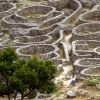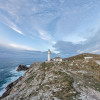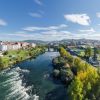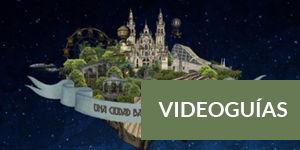- Accede I
- Regístrate I
- carrito
Portugal y Galicia meridional
Duración: 1 día completo
Itinerario: Tui - Valença do Minho - A Guarda - Santa Tegra - Oia - Baiona
Descripción: La relación de ambos países, separados por el río Miño, marca el itinerario, que recorre tierras fronterizas y señoriales, jalonadas de fortalezas defensivas y de miradores, tapizadas de viñedos de la denominación de origen “Rías Baixas”. Se recorre la acrópolis medieval de Tui, liderada por su catedral, para después detenerse en Portugal en la fortaleza de Valença do Minho, enclave fronterizo de interés históricoartístico y a la vez un gran bazar. El monte de Santa Tegra además de su mirador de amplísimo horizonte, cuenta con uno de los mejor conservados y más espectaculares castros de Galicia. Las siguientes paradas de interés son el puerto marinero de A Guarda, y Baiona “La Real”, que además de su casco histórico y de la fortaleza convertida en Parador, es uno de los más prestigiosos puertos deportivos de Galicia. De regreso a Santiago, vista panorámica de Vigo.
Paradas recomendadas
Tui-Valença do Minho (Portugal)-A Guarda-Santa Trega-Oia-Baiona
'Portugal es el amante y Galicia la amada', recoge poéticamente un dicho popular. La relación de los dos países, separados por el vigoroso Miño, marca la primera parte del itinerario de una excursión que es un deleite a la vez paisajístico y monumental, y que reserva tiempo para las compras en un enclave comercial histórico-artístico: la fortaleza de Valença do Minho. Son tierras señoriales sembradas de viñedos, tierras fronterizas, con miradores de un país a otro y fortalezas defensivas.
En tierras gallegas, la excursión recorre por la zona conocida como Baixo Miño, localizada en el extremo suroeste de la provincia de Pontevedra, y que debe su nombre, su paisaje y su personalidad a la presencia del río Miño, el más importante de los cursos fluviales gallegos, que sirve además de frontera con Portugal. La comarca fusiona de forma armoniosa tres tipos de paisaje: el de mar, el de monte y el de río.
Desde la cima del monte de Santa Tegra se domina toda la línea de costa, que es también la zona que recorre esta excursión, comenzando al sur, más allá del Miño, en tierras de Portugal, y finalizando en el norte, con la ría de Vigo y las islas Cíes. El monte de Tui, el Aloia, es, junto con el propio estuario del Miño, un lugar muy valioso desde el punto de vista medioambiental. Tanto el monte de Santa Tegra como el Aloia, situados estratégicamente, son inmejorables miradores naturales que ofrecen preciosas vistas sobre estas tierras, que cuentan con un variado catálogo arquitectónico de todas las época, desde el castro prehistórico de Santa Tegra, pasando por la acrópolis medieval de Tui, el puerto marinero atemporal de A Guarda, el cenobio de Santa María de Oia, y 'La Real' Baiona.
A base de dedicación y buenas condiciones naturales, los vinos de la zona, y especialmente los de O Rosal, han alcanzado resonancia internacional, formando parte de la denominación de origen 'Rías Baixas'. Ellos son el perfecto complemento para la oferta gastronómica de la zona, repleta de todo tipo de productos del río y del mar.
Tui
Situado en la frontera con Portugal, del que queda separado por el río Miño, Tui es una catedral-fortaleza rodeada de iglesias y de casas de granito, muchas de ellas blasonadas o con arcos conopiales de los siglos XV y XVI, que se organizan en calles enlosadas de trazado medieval. Tiene un casco histórico todo de piedra, que conserva restos de la antigua muralla, y es fascinante, con rúas que caen hacia el río y con placitas mirador sobre el país vecino. El casco histórico de Tui, declarado Conjunto Histórico-Artístico, sorprende, además de por su belleza, por su serenidad.
El recorrido más habitual empieza en la Catedral y desciende después por la calle de la Misericordia, donde sale al paso la capilla de San Telmo (1769-1803), patrón de Tui, ejemplar único del Barroco portugués en Galicia, edificada sobre la casa donde murió ese santo dominico en el siglo XIII. Continúa por la calle del Cuerpo Santo para subir por el Pasadizo de las Monjas y visitar el convento de clausura de las Encerradas, monjas clarisas, que destaca por sus grandes proporciones, su solidez constructiva y por las rejas de las ventanas, y donde se pueden comprar unas exquisitas pastas de almendra únicas por su forma de pez, que esconden una historia popular.
Del carácter fronterizo y ribereño de esta población, que fue una de las siete capitales del antiguo Reino de Galicia y que sufrió ataques normandos y árabes, dan cuenta tanto su espectacular ubicación sobre el río, mirando a la fortaleza hermana de Valença do Minho, ya en Portugal, como el viejo puente internacional de hierro, atribuido al famoso ingeniero francés Eiffel. Por Tui pasa, además, el Camino de peregrinación llamado Portugués, que lleva a Santiago de Compostela.
Por su proximidad al mar, la gastronomía tudense es rica en mariscos, pero sobre todo está unida a los productos del Miño, entre los que sobresalen las angulas y las lampreas. Tui, que pertenece a la denominación de origen 'Rías Baixas', riega su gastronomía con exquisitos vinos Albariños.
Portugal: Valença do Minho
La Fortaleza de Valença do Minho es el correlato de la de Tui al otro lado del río, ya en tierras portuguesas. Sin embargo es menos recia y recoleta, más luminosa, y su carácter portugués se nota también en su empedrado, distinto del gallego, y en la blancura de sus edificios, muchos de ellos decorados con un elemento característico de la arquitectura portuguesa: el azulejo. Valença está salpicada de pequeñas iglesitas y hornacinas de estilo barroco. Años atrás, este encantador y colorido enclave histórico-artístico fue la meca comercial a la que los españoles acudían a comprar artículos, sobre todo textiles, muy económicos. Hoy sigue siendo un precioso gran bazar, que ha ampliado la variedad de sus productos y también la gama de precios, que se han aproximado a los españoles.
O Rosal
De vuelta a España, el itinerario continúa hacia A Guarda. Un indicador a la derecha señala el parque natural de monte Aloia, que cuenta con un centro de interpretación. En estas instalaciones se facilitan guías de las distintas rutas de senderismo que recorren el parque, información sobre especies naturales y todo lo necesario para conocer el valor medioambiental de este lugar. Existe la posibilidad de realizar visitas guiadas. El parque dispone además de mesas, lugares de esparcimiento, zonas acotadas para hacer fuego, etc. y tiene además un restaurante al lado de la ermita de San Xulián.
Más adelante está O Rosal, territorio que disfruta de un clima y unas condiciones óptimas para las actividades vitivinícolas. A orillas de la carretera vemos numerosos viñedos, en su gran mayoría de uva albariño. Los vinos de O Rosal están incluidos dentro de la Denominación de Origen 'Rías Baixas', junto con el Albariño y el Condado.
Monte Santa Trega y A Guarda
A escasos kilómetros de O Rosal está A Guarda, uno de los municipios con más encanto de Galicia. El océano Atlántico, el estuario del río Miño, y el monte Santa Trega, conforman un extraordinario marco de gran riqueza natural e histórica, al que hay que unir como atractivo de primer orden la calidad de su gastronomía.
Desde la villa se accede al monte de Santa Trega, con excepcionales miradores sobre la desembocadura del Miño, hacia el sur, y sobre la villa marinera que se acaba de atravesar, hacia el norte. Santa Trega, que está recorrido de senderos, tiene petrogriflos (grabados rupestres) de la Edad del Bronce, y está también el castro, poblado galaico-romano -'celta'- reconstruido y espectacular por su ubicación, declarado Monumento Histórico-Artístico Nacional. Sus importantes restos arqueológicos justifican la existencia de un museo, con objetos que van desde el Paleolítico hasta la época romana. El monte tiene además una pequeña capilla, y dos vía crucis, uno de ellos ornamental, además de dos establecimientos de restauración.
Momasterio de Santa María de Oia
La excursión sale de A Guarda rumbo a Baiona bordeando en todo momento la costa por la carretera conocida como el Rompeolas, lo que garantiza un estupendo paisaje.
A mitad de camino (15 km aprox) está el Monasterio de Santa María de Oia (s. XII), espectacular por su ubicación enfrentada completamente al océano, lo que lo convierte quizá en el único cenobio tan definitivamente relacionado con el mar.
Virxe da roca
Pasado el cabo Silleiro se llega a la 'Virgen de la Roca', que es una estatua de piedra y mármol blanco de grandes dimensiones (15 m de altura) que mira al mar desde una altura de 100 m. Construida por suscripción popular y realizada por el famoso arquitecto Antonio Palacios -que contó con la colaboración en la cara y las manos, del gran escultor valenciano Mariano Benlliure-, su manto arranca de la misma roca del monte llamado Sansón. Una ínfima y vertiginosa escalera de caracol asciende por su interior y lleva al barco que sostiene la Virgen, un balcón que permite contemplar Baiona, la península de la Fortaleza de Monterreal y las islas Cíes en todo su esplendor.
Baiona
Baiona, de apellido 'la Real' en virtud de los privilegios reales que le fueron concedidos en el Medievo para el comercio marítimo, es actualmente un importante enclave turístico. Esta hermosa villa marinera es conocida principalmente por el castillo de Monterreal, antigua fortaleza hoy parador nacional de turismo 'Conde de Gondomar', por su colegiata románica del siglo XIII y por ser el puerto al que arribó después de su periplo la carabela La Pinta, una de las tres embarcaciones con las que Cristóbal Colón descubrió América.
Baiona se ha convertido en una de las localidades más importantes de la navegación deportiva de toda la Península Ibérica. Su puerto alberga a numerosas embarcaciones, que le dan un vistoso aspecto, y sirve de base para la regata Príncipe de Asturias, que se celebra a finales de agosto.
Desde Baiona se sale ya de vuelta a Santiago. Desde la autopista, magníficas vistas de la ría y la ciudad de Vigo.





















